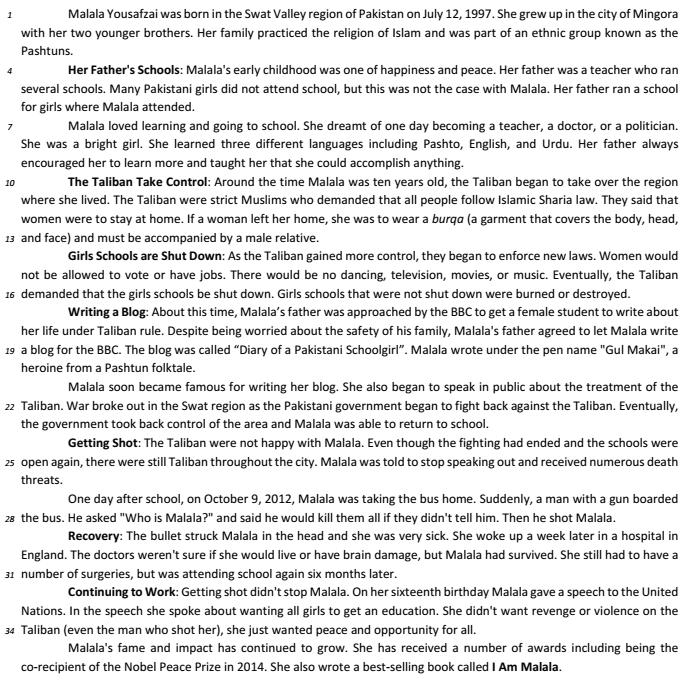Questões de Inglês - Análise sintática | Syntax Parsing para Concurso
Foram encontradas 145 questões
Sign the object in the sentence below.
Your uncle left a message.
Grupo nominal: “the alternating-current electric system”
I. o núcleo do grupo nominal é a palavra “system”. II. o grupo nominal tem dois núcleos “alternating” e “current” III. o fragmento em análise não é um grupo nominal, pois não há verbo.
Leia o texto 1 para responder a questão que se segue.

I. explicativo, pois constata onde ele nasceu. II. argumentativo, pois discute o lugar de nascimento dele. III. temporal, pois marca o tempo cronológico em que ele nasceu.

The term “unfold”, as used in line 17, is an intransitive verb.
Text for the item.

Internet: <www.ducksters.com> (adapted).
According to the text, judge the item.
It is correct to rewrite the extract “As the Taliban gained
more control, they began to enforce new laws.” (line 14)
as News laws had began to be enforced as more control
Taliban gains.
According to the text, judge the item
In the sentence “It doesn't merely involve drawing a family tree” (line 2), the auxiliary “doesn't” is conjugated in the 3rd person
singular to agree with the subject “It”.
No Time to Die, by Billie Eilish and Finneas
I should have known
I'd leave alone
Just goes to show
That the blood you bleed is just the blood you
owe
We were a pair
But I saw you there
Too much to bear
You were my life, but life is far away from fair
Was I stupid to love you?
Was I reckless to help?
Was it obvious to everybody else?
That I'd fallen for a lie
You were never on my side
Fool me once, fool me twice
Are you death or paradise?
Now you'll never see me cry
There's just no time to die
I let it burn
You're no longer my concern, mmm
Faces from my past return
Another lesson yet to learn
That I'd fallen for a lie
You were never on my side
Fool me once, fool me twice
Are you death or paradise?
Now you'll never see me cry
There's just no time to die
Available in: https://www.letras.mus.br/billie-eilish/no-time-to-die/
Every sentence has two main parts, a subject and a predicate. A subject is one of the five major elements of clause structure. The other four are: verb, object, complement and adjunct.
Mark the incorrect statement.
A clause is a group of words that contains a verb (and usually other components too). A clause may form part of a sentence or it may be a complete sentence in itself.
About clauses, it is not correct:
I- The United Nations was founded in 1945. II- Politics is a subject taught in all schools. III- A number of teenagers is playing on the playground. IV- The number of people who own cars is increasing. V- Neither his brother nor his sister work in the hospital.
First column: verb pattern 1- Verb followed by a direct object 2- Verb followed by a direct object and an indirect object 3- Verb with no object
Second column: sentence ( ) I would never have had that coffee if I’d known it would stop me sleeping. ( ) Her eyes shone in the darkness, reflecting the light from the candle. ( ) Ben quietly handed her the letter, looking rather nervous.
Check the correct alternative:
First column: function 1- Give a reason 2- Express condition 3- Show a result
Second column: sentence ( ) It was such an enjoyable party that I stayed longer than I’d planned. ( ) As it might rain at the weekend, I’ve rented a couple of DVDs. ( ) Provided you pay me back next week, I’ll lend you the money.
Check the correct alternative:

Internet: <https://www.english‐online.at>
According to the text, judge the following items.
In “They do not have the money to afford imported food” (lines 17 and 18), “to afford” can be correctly replaced by to
withdraw.
I – Pronouns are words we use in the place of a full sentence. II – We use he/him to refer to men, and she/her to refer to women. When we are not sure if we are talking about a man or a woman we use they/them. III – English clauses Always have a subject. If there is no other subject we use it or there. We cal this a dummy subject.
How many items are correct?
An interview with Paolo Kwan, 20, from Hong Kong, who is improving his English while studying Business Administration at Sierra College in northern California.
WHY DID YOU DECIDE TO STUDY IN THE USA?
It provides a nice education in a beautiful country. When I
was younger I used to watch American movies and I
wanted to visit the United States. They always talked about
the American dream, and I wanted to come and see it.
HOW DID YOU CHOOSE YOUR INTENSIVE ENGLISH PROGRAM?
Sierra College is one of the biggest community colleges in northern California. It is in a quiet location but has a beautiful campus.
The college has a good business program. I can study for two years at Sierra College and then two years at my transfer school to earn my degree.
WHAT DO YOU LIKE BEST?
I also enjoy the quality of the teaching at the college. There is a writing center where I can go at any time. The teachers can make suggestions to improve my essay, regarding grammar and my vocabulary. At the Math Center, they can explain in detail the problems.
WHAT DO YOU MISS MOST?
I miss the food and also my family.
WHAT WAS YOUR BIGGEST SURPRISE?
I was surprised by the cultural difference. The taste and style of food is very different. The amount of food is a lot larger. A small portion in the USA is a large portion in Hong Kong. When people from America find out that I am from another country they ask a lot of questions. They are very interested in you and finding out about Hong Kong.
... YOUR BIGGEST DISAPPOINTMENT?
I have not had any since I came here.
HOW HAVE YOU HANDLED:
... LANGUAGE DIFFERENCES?
It is important not to be shy, as that does not help you when you are trying to improve your language. I make sure that I study, practice and speak as often as I can—that is the only way to improve. ...
FINANCES?
I am being supported by my family.
... ADJUSTING TO A DIFFERENT EDUCATIONAL SYSTEM?
The American system is much more open. In Hong Kong you just learn what the teacher writes on the board. In America, you discuss the issues and focus more on ideas
WHAT ARE YOUR ACTIVITIES?
I am interested in traveling around the USA. I have been to San Francisco, which you can reach by train from Sierra College. In my free time I go out with friends.
HOW EASY OR DIFFICULT IS MAKING FRIENDS?
It has not been that hard to make friends in the USA. Other people at the college are friendly and want to make friends as well.
HOW IS YOUR U.S. EDUCATION RELEVANT TO YOUR PERSONAL GOALS AND TO THE NEEDS OF YOUR COUNTRY?
I think that the U.S. education system will provide me with
good resources and skills to be able to support myself in
order to get hired in my own country
WHAT IS YOUR ADVICE TO OTHER STUDENTS?
An awesome life experience is waiting for you in the future. You will learn so much more than you think. Nothing is impossible, so go ahead and give it a try.
Adapted from: https://www.studyusa.com
Text 1:
How being bilingual can boost your career
Whether you’re fresh out of college or a seasoned executive, insiders agree that fluency in a second language can not only help you stand out among prospective employers, it can also open doors to opportunities that those without foreign language skills might miss.
In today’s global economy, the ability to communicate in another language has become a significant advantage in the workforce. Research has found that people who speak at least one foreign language have an average annual household income that’s $10,000 higher than the household income of those who only speak English. And about 17 percent of those who speak at least one foreign language earn more than $100,000 a year.
A recent survey found that nearly 9 out of 10 headhunters in Europe, Latin America, and Asia say that being at least bilingual is critical for success in today’s business environment. And 66 percent of North American recruiters agreed that being bilingual will be increasingly important in the next 10 years.
“In today’s global economy you really have to understand the way business is done overseas to maximize your potential. A second language equips you for that,” says Alister Wellesley, managing partner of a Connecticut-based recruiting firm. “If you’re doing business overseas, or with someone from overseas, you obtain a certain degree of respect if you’re able to talk in their native language.”
Language skills can also be key for service industries. At the Willard InterContinental Washington, a luxury hotel a few blocks from the White House, a staff of about 570 represents 42 nations, speaking 19 languages. The Willard’s front-of-house employees such as the concierge speak at least two languages. Bilingualism is not an absolute requirement, but it is desirable, according to Wendi Colby, director of human resources.
Workers with skills in a second language may have an edge when it comes to climbing Willard’s professional ladder. “The individual that spoke more languages would have a better chance for a managerial role, whatever the next level would be,” Colby says. “They are able to deal with a wide array of clients, employees.”
So which languages can give you a leg up on the job market? Insiders agree the most popular – and marketable – languages are Spanish, German, French, Italian, Russian and Japanese, with a growing emphasis on Mandarin, given China’s booming economy. So let’s learn Mandarin!
“We see demand from a full range of industries,” says Wellesley. “Actually it depends on which company you’re working for and the country in which they’re located.”
Adapted from: LATHAM-KOENIG, Christina & OXENDEN,
Clive. American English File 5. 2nd edition. Oxford: OUP,
2018.
